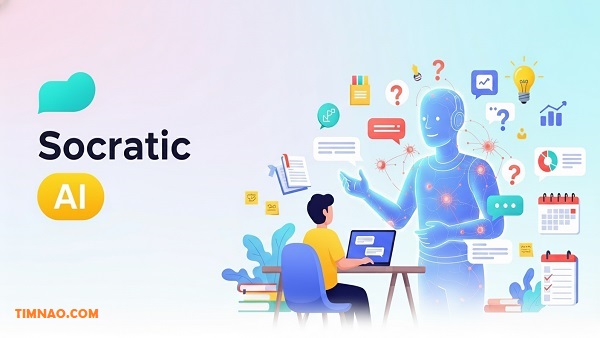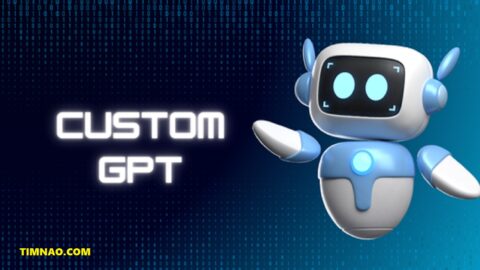Socratic AI Success: The Ultimate Friendly Guide for Beginners 🚀
Socratic AI is transforming how people think about conversational AI for beginners. Instead of simply giving quick answers, it guides you with questions, nudges, and reflections so you can build your own understanding. This style of ai problem solving feels less like using a search engine and more like talking to a thoughtful coach who wants you to grow.
In this guide, you’ll learn exactly what Socratic AI is, how it works, and where you can actually use it today. We’ll explore real tools you can try, practical workflows for your daily life and work, and a simple 30-day roadmap to build long-term skills. Along the way, everything will stay beginner-friendly, with short paragraphs, clear language, and lots of concrete examples.
Whether you want to study smarter, make better decisions, or be more creative, Socratic AI can become a powerful thinking partner. You don’t need a technical background or advanced AI knowledge. You just need curiosity, a device with internet, and a willingness to have deeper conversations with your tools.
💡 What Is Socratic AI and Why It Matters
The Simple Definition (No Philosophy Degree Needed)
At its core, Socratic AI is just this:
An AI that helps you think by asking questions, not just throwing answers at you.
Instead of giving you a final solution right away, a Socratic AI might say things like:
- “What have you already tried?”
- “What does ‘success’ look like for you here?”
- “Are there other options you haven’t considered yet?”
This style comes from Socrates, the ancient Greek philosopher who taught by asking questions. He believed people learn best when they discover answers themselves, not when someone lectures at them. Socratic AI borrows that same approach and applies it to conversational ai for beginners.
Socratic AI vs “Just Give Me the Answer” AI
Most people use AI today like a smarter search engine. You ask a question, it gives a neat, confident answer, and you move on. That’s convenient, but it can be a trap. You may get information, but you don’t build understanding, judgment, or real skill.
Socratic AI flips that pattern:
- Normal AI assistant:
“Here’s the answer. Copy, paste, done.” - Socratic AI assistant:
“Before we jump to an answer, what do you already know? What’s your goal? What constraints are you dealing with?”
With Socratic AI, the conversation takes a tiny bit longer, but your brain is doing more work. That’s a good thing. Over time, this helps you become better at ai problem solving, not just better at copying AI outputs.
Why Socratic AI Is Perfect for Beginners
If you’re new to AI, you might worry you’re “not technical enough” or that you’ll ask the “wrong questions.” Socratic AI actually makes things easier for you, because the AI itself guides the conversation.
Here’s why this matters so much for beginners:
- It reduces pressure. You don’t need the perfect question. You can start messy, and the AI helps you clarify.
- It teaches you how to think with AI. You don’t just get answers; you see how to break problems into smaller, solvable pieces.
- It builds confidence. Every time the AI helps you see your own ideas more clearly, you trust yourself a bit more.
Think of Socratic AI as “AI with training wheels for your thinking.” The tool is still powerful, but it’s supporting your learning instead of hiding the process.
Real-Life Situations Where Socratic AI Shines
Let’s make this concrete. Here are a few examples where Socratic AI works beautifully:
- Career choices: Instead of “What job should I do?”, you get questions about your strengths, motivations, risk tolerance, and lifestyle.
- Studying: Instead of AI doing your homework, it asks you to explain your reasoning, points out gaps, and nudges you toward the right concept.
- Personal habits: Instead of a generic morning routine, you get questions about your energy, schedule, and what’s realistically sustainable for you.
In each case, the AI isn’t acting like a know-it-all. It’s acting like a smart coach that wants you to understand yourself and your situation first.
🧠 How Socratic AI Actually Works (Without the Jargon)
A Friendly Look Inside: What’s Going On Under the Hood
Most Socratic AI experiences are powered by large language models (LLMs). Names you probably recognize include:
You don’t need to be an engineer to use them. What matters is understanding how they behave so you can steer them.
Here’s a simple way to picture it:
- You type a message.
- The AI breaks your text into tiny pieces (tokens).
- It looks at the words, the context, and everything that came before.
- It predicts the most likely next token, again and again, until it forms a full answer.
It’s not “thinking” the way humans do, but it has seen so many examples of conversation, explanation, and reasoning that it can simulate a thoughtful response surprisingly well.
What Makes an AI “Socratic” Instead of Just “Chatty”
Technically, there is no magic “Socratic chip” inside the AI. The difference between a normal assistant and a Socratic one comes from instructions and habits.
There are two big ingredients:
- The system or role you give it
You tell the AI how to behave. For example:“From now on, act as a Socratic coach. Ask me questions first to understand my goal and situation. Only suggest answers after we’ve explored the problem together.”
- The way you interact with it
You actually respond to its questions and resist asking “Just give me the answer” every two messages. You treat the AI like a coach, not a vending machine.
Together, these two pieces turn a regular LLM into a socratic ai partner for thinking and learning.
A Simple Socratic AI Flow You Can Copy
Here’s a practical mini-framework you can use with almost any tool:
- Set the role
“You are a Socratic AI mentor helping me with ai problem solving. Ask clarifying questions before you give any suggestions.”
- Describe your situation (even if it’s messy)
Example:“I feel stuck at work. I like my team but feel my growth is slow. I’m not sure if I should change jobs, switch roles, or stay and improve where I am.”
- Let the AI question you
It may ask about your values, career goals, time horizon, and what you’ve tried. Answer honestly, even if you’re unsure. - Ask for structure, not just solutions
After a few rounds of questions, say something like:“Summarize what we’ve uncovered so far, then suggest 2–3 possible paths with pros and cons for each.”
- Decide your next step
Use the AI’s summary and options to choose one small action to try this week. You stay the decision-maker.
This pattern works for career choices, study plans, business strategy, health habits, and more. The underlying AI is the same—but the style is now Socratic.
Why This Approach Is So Powerful for AI Problem Solving
When you use AI in a Socratic way, you naturally:
- Slow down just enough to avoid impulsive decisions.
- Surface hidden assumptions (“I thought I had to do X before Y, but maybe I don’t”).
- See multiple angles on the same problem instead of locking into a single narrative.
Over time, this trains your mind to think more clearly, even without AI. You’re not just offloading tasks; you’re upgrading your thinking patterns.
🌐 Where to Find Socratic AI Tools Today
Dedicated Learning Tools with Socratic Flavor
Some platforms are built from the ground up around the idea of Socratic-style learning and questioning.
Here are a few you can explore:
- Socratic by Google – socratic.com
A mobile app for students that lets you snap a photo of a question and get explanations, videos, and guiding steps. Great if you’re stuck on math, science, or homework and want to understand, not just copy. - Khan Academy’s Khanmigo – khanmigo.ai
Khanmigo is Khan Academy’s AI tutor. It’s built to behave like a patient teacher: asking you to show your work, nudging you when you’re close, and avoiding simply giving away answers. Perfect if you’re studying school subjects and want a companion that “talks you through” the process. - Medical and professional training tools like GetSocratic / SOCRATIC AI
These are more specialized. They simulate real-world scenarios (like patient cases) and use Socratic questioning to help learners reason through each step instead of memorizing.
If you’re a beginner, starting with Socratic by Google or Khanmigo is an easy way to experience Socratic-style AI in a structured, safe environment.
General AI Assistants You Can Turn into Socratic AI
You don’t have to wait for a special “Socratic AI” product. Many mainstream tools can become Socratic just by the way you use them. Here are some common options:
- ChatGPT
Great all-rounder for conversational ai for beginners. You can explicitly tell it to act as a Socratic coach or tutor and use it for everything from writing, planning, and coding to reflection and life design. - Google Gemini
Strong choice if you live in the Google ecosystem (Docs, Sheets, Gmail). You can ask it to question you before drafting documents or plans, making it a handy Socratic assistant for work and study. - Microsoft Copilot
Integrated into Word, Excel, PowerPoint, and Teams. You can use Socratic prompts to refine reports, presentations, or decision memos by asking it to challenge your assumptions and highlight missing points. - Claude
Especially good for long-form text and deep reasoning. If you want to have thoughtful, reflective conversations or have it critique your thinking in detail, Claude can be a great Socratic partner.
For ai problem solving, these tools are like “blank canvases” that you can shape. The trick is to:
- Give them a clear Socratic role (coach, tutor, thought partner).
- Ask them to prioritize questions over direct answers.
- Follow through by actually engaging with the questions.
How to Choose the Right Socratic AI Starting Point
If you’re wondering where to start, here’s a simple guide:
- You’re a student or parent → Try Socratic by Google or Khanmigo.
- You mainly want personal growth and everyday guidance → Start with ChatGPT and practice Socratic-style prompts.
- You live in Google Docs/Gmail → Use Google Gemini to help with planning, writing, and decision-making through questions.
- You live in Microsoft 365 → Use Microsoft Copilot with Socratic prompts for reports, presentations, and email.
Don’t overthink it. Pick one tool, commit to using it in a Socratic way for 1–2 weeks, and observe how your comfort with AI—and your own thinking—evolves. Once you’re comfortable, you can mix and match tools as needed.
🗣️ Getting Started: Your First Conversations with Socratic AI
Start Small: One Tool, One Goal
When you’re new to socratic ai, the fastest way to get stuck is trying too many tools and ideas at once. Instead, pick one AI assistant you’re comfortable with—maybe ChatGPT, Google Gemini, or Microsoft Copilot—and use it as your base. You don’t need to understand every feature; you just need a chat box where you can type. Then pick one simple goal for your first week, like “plan my week better” or “understand a topic I find confusing.” Clear focus makes conversational ai for beginners feel much less overwhelming.
Give Your AI a Clear Socratic Role
Most people open an AI chat and type a question right away. With Socratic AI, you’ll get better results if you set the role first. That simply means telling the AI how you want it to behave. For example, you might say:
“You are a Socratic coach. Ask me questions before you give advice. Help me think clearly, not just get quick answers.”
This one short instruction nudges the AI into a more thoughtful, question-first mode and makes the rest of the conversation more useful.
Use Real Problems, Not Random Examples
A lot of tutorials give you fake scenarios, like “Pretend you want to open a coffee shop.” That can be helpful at first, but you will learn much faster if you bring real situations from your life. For example, you might say:
“I feel disorganized. I’m juggling work, family, and studying, and I keep dropping things. Help me figure out what’s going wrong.”
Because the problem is real, your answers to the AI’s questions will be more honest and detailed. That means Socratic AI has better material to work with for ai problem solving.
A Simple First-Conversation Script You Can Copy
If you’re not sure how to begin, here’s a simple script you can paste into your AI tool:
“I’m new to using AI. Act as a Socratic partner and help me think more clearly. First, ask me 3–5 questions to understand my situation. Then summarize what you heard and suggest 2–3 options I could consider. Don’t decide for me—help me weigh the options.”
After the AI responds, answer each question honestly in short paragraphs. Don’t worry about sounding “smart”; just be real. When it gives you the summary and options, read them slowly and notice where you feel a sense of curiosity, tension, or resistance—those feelings are clues to what matters to you.
Turn Conversations into a Light Daily Habit
One conversation is helpful; a tiny daily habit is powerful. You could decide that every evening you’ll open your AI tool for 10 minutes and reflect on your day Socratic-style. For example:
“Ask me three questions: What went well today? What didn’t go well? What can I try differently tomorrow? Then help me write a one-sentence intention for tomorrow.”
This simple routine trains you to use conversational ai for beginners as a thinking partner, not just a last-minute emergency helper.
Common Beginner Mistakes (and How to Avoid Them)
When people start with Socratic AI, they often fall into a few predictable traps. One is asking for the answer too soon—for example, “Just tell me what to do.” Try to notice when you’re impatient and let the AI finish its questioning phase. Another mistake is giving very short, vague answers to deep questions. If the AI asks, “What worries you most about this decision?”, a one-word answer like “failure” won’t help much. Take 3–4 sentences and unpack your thoughts. The more you share, the more useful Socratic AI becomes.
🧩 Everyday AI Problem Solving with Socratic AI
Using Socratic AI to Untangle Your To-Do List
One of the most practical uses of Socratic AI is cleaning up your messy to-do list. Instead of asking, “How do I get more done?”, you can paste your tasks into the chat and say:
“Act as a Socratic productivity coach. Ask me questions about urgency, importance, and energy. Then help me group tasks into: do today, do this week, schedule later, delegate, delete.”
The AI might ask which tasks have real deadlines, which ones are self-imposed, and which ones are connected to your long-term goals. As you answer, you’ll often realize some tasks don’t matter as much as you thought.
A Simple Framework for AI Problem Solving
To use socratic ai for everyday problems, it helps to have a repeatable pattern. Here’s a simple framework you can apply to almost anything:
- Describe the situation in 3–5 sentences.
- Ask the AI:
“Ask me about causes, constraints, and what ‘success’ would look like.”
- Answer its questions honestly and with enough detail.
- Then say:
“Summarize what you heard. Suggest 2–3 possible ways forward, including the trade-offs of each.”
This keeps the AI focused on ai problem solving through understanding, not just generating generic advice. You stay in control while the AI gives structure and options.
Everyday Use Case: Personal Decisions
Let’s say you’re deciding whether to move to a new city, switch departments, or start a side project. Instead of asking, “Should I do it?”, try this:
- Start with:
“Help me explore this decision Socratically. Ask about my values, fears, time horizon, and what I’d regret more in 5 years.”
- Answer each question with a short paragraph.
- When the AI summarizes your situation, ask it to create a small comparison table of your options, with pros, cons, and risks.
You’ll likely discover the decision isn’t just about “good vs bad” but about what you value more right now—stability, growth, learning, location, or relationships.
Everyday Use Case: Designing Better Habits
Habits are a perfect playground for conversational ai for beginners. For example, imagine you want to build a reading habit but keep reaching for your phone instead. You could say:
“Act as a Socratic habit coach. Ask me about my current evening routine, energy levels, environment, and triggers. Then help me design a simple 20-minute reading habit I can realistically stick to.”
The AI may ask where your phone is at night, what time you usually feel sleepy, what you’re reading, and what gets in the way. With that information, it can help you design small, specific actions like “Place my phone in another room at 10pm and keep my book on the pillow.” Tiny details make new habits actually doable.
Everyday Use Case: Relationships and Communication
You can also use Socratic AI to think through tricky conversations—with a partner, colleague, or friend. For example:
“I need to have a difficult conversation with a coworker. Help me clarify my goals and fears by asking questions. Then help me draft a message or script that’s honest but calm.”
The AI might ask what outcome you really want, what you’re afraid might happen, and which words could easily be misunderstood. After a round of questions, it can help you shape a script that feels more grounded and respectful. You still choose what to say, but Socratic AI makes you more intentional.
Turning Problems into Experiments
A powerful mindset shift is to see problems as experiments instead of final verdicts about you. When working with Socratic AI, you can end each problem-solving session by asking:
“Given everything we discussed, suggest one small experiment I can run over the next 3–7 days. It should be low-risk, easy to try, and give me information about what works for me.”
This keeps you moving and learning, instead of waiting for the “perfect” plan. Over time, you build a life full of small, smart experiments guided by your own reflection plus AI support.
📚 Learning Faster with Socratic AI Tutors
Why Socratic Tutoring Works So Well
If you’ve ever crammed for a test and then forgotten everything a week later, you already know that passive learning doesn’t stick. Socratic tutoring flips that around. Instead of an AI explaining everything step by step while you sit back, the AI keeps pulling you into the process with questions. You’re forced to recall, connect, and explain—which is exactly how the brain builds long-term understanding.
This makes Socratic AI a perfect form of conversational ai for beginners who want to learn new topics without feeling lost. You don’t need to know how to design a full study plan. You just need to let the AI ask questions and be willing to answer them, even when you’re unsure.
Tools That Already Support Socratic-Style Learning
Several platforms already lean heavily into Socratic-style tutoring:
- Socratic by Google helps students understand school subjects by breaking problems into manageable steps and linking to explanations.
- Khan Academy’s Khanmigo acts like a private tutor that encourages you to show your work.
- General AI tools like ChatGPT and Claude can be turned into tutors with the right prompts.
The important thing is not which tool you use, but how you use it. Even the best AI tutor becomes useless if you insist, “Just solve this for me” every time.
A Step-by-Step Socratic Study Session
Here’s a simple structure you can follow for any topic—math, coding, finance, history, anything:
- Tell the AI what you’re learning and your level.
“I’m a beginner learning basic statistics. I mostly struggle with understanding variance and standard deviation.”
- Ask it to teach Socratically.
“Teach me using Socratic questions. Don’t move on until I attempt an answer.”
- Engage fully with the questions.
When it asks, “What do you think variance measures?”, try to explain in your own words, even if you’re not confident. - Request a recap and practice.
“Summarize what I’ve understood correctly, then give me 3 practice questions with hints, not full solutions.”
In 20–30 minutes, you’ll have done serious, active learning instead of just passively scrolling through explanations.
Using Socratic AI to Prepare for Exams or Interviews
If you’re preparing for an exam, certification, or job interview, socratic ai can act like a custom examiner. For example, you could say:
“I’m preparing for a junior data analyst interview. Act as an interviewer. Ask me one question at a time, wait for my answer, then critique my response and suggest a stronger version.”
This approach forces you to speak or write your answers clearly. The AI then highlights gaps, suggests better phrasing, and asks follow-up questions that go deeper. Over a few sessions, you’ll feel more confident and sound more articulate.
“Teach Back” Method: Learn by Explaining to the AI
One of the most powerful learning tricks is to teach a topic back to someone else. With Socratic AI, you can simulate that anytime. For example:
“I will try to explain how neural networks work in simple terms. After I’m done, act as a curious student and ask questions where my explanation is unclear, incomplete, or inaccurate.”
As you explain, you’ll notice where you hesitate—that’s where your understanding is fuzzy. When the AI asks follow-up questions, it’s like shining a light on the exact spots you need to strengthen. You can then ask it for targeted explanations or examples in those areas.
Building a Weekly Learning Routine with Socratic AI
To make learning with AI sustainable, turn it into a routine. Here’s a simple weekly structure you can try:
- Day 1: Ask your AI to create a 7-day micro-plan on one topic (for example, “introduction to personal finance” or “Python basics”).
- Day 2–6: Each day, spend 20–30 minutes in Socratic mode—answering questions, doing short exercises, and reviewing mistakes.
- Day 7: Ask the AI to test you with a mini-quiz, then summarize your progress and suggest what to focus on next week.
This pattern keeps you moving forward steadily without feeling like you need hours of study time. Over a few weeks, you’ll be shocked at how much more confident you feel in areas that once felt confusing.
💼 Using Socratic AI at Work and in Business
Rethinking AI at Work: From Auto-Pilot to Co-Pilot
A lot of people hear “AI at work” and immediately think of automation stealing jobs. But if you approach it as socratic ai, the goal shifts from replacing people to helping them think and decide better. Instead of “AI will do my job,” the mindset becomes “AI will help me do my job with more clarity, speed, and confidence.”
When you bring Socratic AI into your workday, you’re not just asking it to write emails or summarize documents. You’re asking it to question your assumptions, expose blind spots, and help you design better options. That’s a fundamental shift in how you use tools like ChatGPT, Google Gemini, or Microsoft Copilot.
The most important thing is this: you stay the decision-maker. Socratic AI is there to challenge, clarify, and support—not to take over.
Socratic AI for Knowledge Workers
If your work involves writing, planning, analyzing, or coordinating, you’re a knowledge worker. For you, using conversational ai for beginners in a Socratic way can feel like having a personal thinking partner on demand.
Here are a few practical examples:
- Writing a report:
Paste your rough notes into Notion or Microsoft Word where Copilot or another AI is available. Ask:“Act as a Socratic editor. Ask me who the audience is, what decision this report should support, and what absolutely must be clear. Then help me outline sections.”
- Planning a project:
Inside tools like Trello, Asana, or Jira, you can work with AI to define milestones and risks:“Ask me questions about scope, deadlines, and resources. Then suggest a simple 3-phase project structure with checkpoints.”
In both cases, the AI is guiding you through ai problem solving, not just filling in templates. You end up with work that reflects your reality, not generic advice.
Socratic AI for Meetings and Communication
Meetings are one of the biggest time sinks in most organizations. Socratic AI can help you prepare, participate, and follow up far more effectively.
Before a meeting, you can ask an assistant like ChatGPT or Google Gemini:
“Here’s the meeting agenda. Ask me why I’m invited, what outcome I want, and what decisions need to be made. Then help me write 3 clear questions I can bring to the meeting.”
This is especially powerful if you’re shy or tend to stay quiet in group settings. Having pre-thought questions gives you something solid to contribute.
After the meeting, if you have notes in tools like Microsoft Teams or Zoom, you can ask AI to:
- Summarize key decisions
- List open questions
- Suggest next actions and owners
You can even say:
“Challenge this summary. What might be missing or unclear for someone who wasn’t in the room?”
That extra Socratic step often reveals gaps early, before they turn into confusion or conflict.
Socratic AI for Small Business Owners and Freelancers
If you run a small business, you probably don’t have a strategy department, a financial analyst, and a marketing team. You have… you. This is where socratic ai can feel like a mini advisory board.
Try using AI this way:
- Business health check:
“Act as a Socratic business coach. Ask me about my revenue streams, biggest costs, customer types, and current worries. Then help me identify one area where a small improvement this month could have a big impact.”
- Offer design:
“Ask me questions about what my clients struggle with most, what I enjoy doing, and what delivers the most results. Then suggest 2–3 potential offers I could refine.”
- Marketing experiments:
Use AI inside tools like Canva (for visuals) or Mailchimp (for email campaigns) to clarify messaging:“Interview me about my target audience, their fears, and desired outcomes. Then help me write three short value propositions from different angles.”
Because Socratic AI keeps questioning you, your business decisions become more grounded in reality rather than random ideas.
Bringing Socratic AI into Team Culture
You can also use conversational AI for beginners at the team level, not just individually. For example, in a team chat tool like Slack or Microsoft Teams, you might create a channel where the “AI bot” plays a Socratic role.
Team members could tag the bot with prompts like:
- “We’re considering changing our pricing. Ask us questions about customer impact, revenue risk, and long-term positioning.”
- “We’re choosing between feature A and B. Help us articulate the pros, cons, and assumptions behind each.”
Over time, people start absorbing these Socratic patterns. Even when the AI isn’t present, teammates naturally ask more thoughtful questions—and that’s when you know the culture is evolving.
🤝 Staying Safe, Ethical, and In Control
Understanding What AI Can and Can’t Do
To use socratic ai wisely, you need a clear sense of its limits. AI is excellent at pattern-matching, generating text, and suggesting options. It is not good at understanding your personal context, your values, or the real-world consequences of your choices.
In other words, AI can help with ai problem solving, but it cannot carry the moral weight of your decisions. That responsibility stays with you. This becomes especially important in areas like hiring, performance reviews, health decisions, or financial planning.
A good rule of thumb:
“Let AI help you think, but never let it think for you.”
Protecting Your Privacy and Sensitive Data
Most conversational ai for beginners tools are cloud-based, which means your inputs travel to a server somewhere to be processed. Some platforms allow you to opt out of training or use enterprise modes where data is more tightly controlled, but you should never assume perfect privacy.
A few practical guidelines:
- Don’t paste passwords, bank account numbers, or private IDs into any AI tool.
- When discussing sensitive cases (like HR issues), anonymize names and identifying details.
- If your company offers approved AI tools (for example, an enterprise version of Microsoft Copilot or ChatGPT), use those instead of random free tools for work data.
You can even ask the AI itself:
“Explain how my data is handled in this product. Summarize the key privacy points in simple terms.”
That won’t replace reading policies, but it can make them easier to understand.
Recognizing and Challenging Bias
AI systems learn from human-created data, which means they also learn human biases. This can show up as stereotypes, skewed recommendations, or missing perspectives. When you’re using Socratic AI, it’s smart to turn the Socratic lens back onto the AI.
Whenever you receive advice or analysis, try questions like:
- “What assumptions are you making here?”
- “Which groups or perspectives might be underrepresented in this answer?”
- “How could this recommendation be unfair or harmful to some people?”
If you’re working on policies, hiring, or high-stakes decisions, consider using multiple tools—such as ChatGPT, Claude, and Google Gemini—to compare outputs. Differences between them can reveal bias or blind spots you might miss if you only use one system.
Keeping Humans in the Loop
As AI becomes more capable, the temptation grows to “just let it handle things.” For example, you might be tempted to let Microsoft Copilot draft and send emails automatically, or let an AI chatbot reply to customers without oversight.
For low-risk cases (like simple confirmations or meeting reminders), this can be fine. But for anything sensitive—feedback, conflict, negotiations—you should always review the AI’s output and adjust it. Think of AI as version 0.7 of your communication, not the final send.
You might even build this into your prompt:
“Draft this email in my voice. Then list 2–3 parts I should review carefully where tone or clarity might be sensitive.”
That reminder nudges you to stay responsible for the message.
Avoiding Over-Dependence and Burnout
One unexpected risk of easy AI access is mental laziness. If you let AI think for you all the time, your own muscles for focus, creativity, and reasoning can get weaker. Ironically, Socratic AI is one of the best antidotes to this—if you actually engage with it.
Here are a few healthy boundaries:
- Use AI to check your thinking, not to replace it completely.
- Schedule “AI-off” time where you intentionally work, journal, or brainstorm without tools.
- When you feel overwhelmed, use AI to help you simplify—not to pile on more options.
For example:“I feel overloaded by advice. Help me narrow this to 2 realistic options and one small step I can take this week.”
Remember, the goal is a partnership that makes you sharper and calmer, not more stressed and dependent.
🚶♀️ A 30-Day Beginner Plan for Conversational AI
Why a 30-Day Plan Helps So Much
It’s easy to read about socratic ai and think, “Wow, that’s cool,” then… never actually use it. A simple 30-day plan bridges that gap. It’s long enough to build real comfort with conversational ai for beginners, but short enough that it doesn’t feel like a life commitment.
The aim of this plan is not to turn you into an AI expert. It’s to help you:
- Build a light daily habit
- Explore ai problem solving in real areas of your life
- Learn what works for you (and what doesn’t)
- End the month feeling like AI is a trusted thinking partner, not a mysterious black box
You can run this plan with any major tool—ChatGPT, Google Gemini, Microsoft Copilot, or Claude.
Week 1 – Getting Comfortable and Curious
Goal: Explore, play, and remove fear.
- Day 1–2: Tool setup and first chats
Create or log into your chosen AI account. Start with light prompts like:“Explain what Socratic AI is as if I were 12 years old, with examples.”
or
“Ask me 5 questions to understand what I want from AI over the next month.” - Day 3–4: Socratic role experiments
Test different roles:“Act as a Socratic life coach.”
“Act as a Socratic productivity mentor.”
“Act as a Socratic learning tutor for [topic].” - Day 5–7: Reflection mini-habit
Each evening, spend 10 minutes with a prompt like:“Ask me what went well today, what was hard, and what I learned. Then help me write one sentence about how I want to show up tomorrow.”
By the end of Week 1, you should feel less nervous and more curious about using AI as a thinking partner.
Week 2 – Focus on One Real-Life Problem
Goal: Experience meaningful ai problem solving with Socratic support.
- Day 8–9: Choose your focus area
Pick one: work stress, health habits, finances, learning a skill, or relationships. Tell your AI:“For the next 7 days, help me work on [focus area] using Socratic questions.”
- Day 10–12: Deep dive through questions
Let the AI interview you about your history, fears, attempts, and goals in that area. Answer in honest paragraphs, not one-word replies. - Day 13–14: Design and start a small experiment
Ask the AI to:“Summarize what we’ve discussed about this problem. Then suggest one simple 7-day experiment I can run to improve it.”
Run the experiment. For example, a new morning routine, a budget tweak, a study schedule, or a communication change. Use AI for small daily check-ins.
Week 3 – Learning Project with a Socratic Tutor
Goal: Use conversational ai for beginners as a consistent learning coach.
- Day 15–16: Pick a topic to learn
It could be “personal finance basics,” “Excel for work,” “public speaking,” or “nutrition.” Tell the AI:“Design a 14-day learning path with daily 20-minute activities. Teach me through Socratic questions and short explanations.”
- Day 17–20: Daily Socratic sessions
Each day:- Let the AI ask you questions about the day’s topic.
- Try to answer from memory first.
- Ask for clarification only after you’ve tried.
- Day 21: Midpoint review
Ask:“Summarize what I’ve learned so far and where I still seem confused. Suggest a few targeted exercises to strengthen my weak spots.”
- Day 22–21: Continue short sessions, focusing particularly on the weaker areas.
By the end of Week 3, you’ll see how Socratic AI can turn intimidating subjects into manageable conversations.
Week 4 – Bringing Socratic AI into Work or Business
Goal: Create one repeatable, AI-supported workflow that saves time and improves quality.
- Day 22–23: Choose a work process to upgrade
Examples: weekly report writing, client emails, meeting prep, data summaries. Tell the AI:“Help me improve this process. Ask me where I lose time, what I dislike, and what ‘great’ would look like.”
- Day 24–26: Co-design a new workflow
Work with the AI to define:- Input (what you give the AI)
- Steps (questions, drafts, reviews)
- Output (what you deliver and to whom)
For example, you might create a new system where you drop bullet points into Notion or Google Docs and have the AI expand, question, and refine before you finalize.
- Day 27–29: Run the workflow in real life
Use the new workflow on real tasks. Pay attention to time saved, clarity gained, and stress reduced. Tweak the prompts as needed. - Day 30: Review, celebrate, and decide next steps
Ask your AI:“Help me reflect on the last 30 days. What changed in how I use AI? What feels easier now? What’s one habit I want to keep for the next 3 months?”
You don’t need a perfect month. Even if you follow 60–70% of this plan, you’ll end up far more confident, with concrete examples of how Socratic AI makes your life and work better.
🔮 The Future of Socratic AI and Your Role in It
Socratic AI is still in its early days, but the direction is already clear: we’re moving from simple chatbots to thinking partners that can guide you through complex decisions, projects, and learning journeys. For beginners, this is great news. It means that socratic ai and other forms of conversational ai for beginners will only get easier to use and more helpful over time. Instead of asking, “Will AI replace me?”, a more useful question is, “How can I grow alongside AI so I stay valuable and confident?”
In the near future, AI assistants won’t just live in a single chat window. They’ll be woven into tools you already use every day—email, documents, spreadsheets, browsers, and messaging apps. Imagine your writing tool quietly suggesting better structure for a report, or your calendar asking Socratic-style questions before you agree to a new commitment. Socratic AI won’t be a separate thing you “go to”; it will be a mode of interaction built into the apps around you.
We’ll also see more specialized Socratic systems for areas like health, law, finance, and education. These tools will combine domain knowledge with question-based coaching to help you understand the why behind each recommendation. That makes ai problem solving more transparent and less mysterious. Instead of “Trust me, I’m AI,” the experience becomes, “Let me show you how we get there, step by step.”
At the same time, this future needs people who use AI wisely. Your role is not to become a passive consumer of AI advice but to be an active partner. Think of yourself as the captain and Socratic AI as your first officer: it suggests routes, asks about risks, and highlights options, but you choose where to go. The more comfortable you get with this partnership now, the more prepared you’ll be as tools become smarter and more deeply integrated into work and life.
The skills that will age well are surprisingly human: asking good questions, spotting weak arguments, understanding your own values, and communicating decisions clearly. Socratic AI can help you practice all of these, but it cannot replace them. In that sense, the future of socratic ai is really the future of you becoming a better thinker with the help of machines that nudge you in the right direction.
One practical thing you can do today is build a “Socratic stack” of tools that suit your life. Maybe you use ChatGPT for personal reflection, Google Gemini for planning and writing, and Microsoft Copilot for work documents and presentations. You don’t need everything at once; just pick tools that fit your context and gradually train them—with your prompts—to behave in a Socratic way.
Most importantly, keep a flexible, learning-focused mindset. AI will change fast. Interfaces will evolve, features will appear and disappear, and new brands will come and go. If you anchor yourself to one product, you’ll feel lost when it changes. But if you anchor yourself to the Socratic style of thinking with AI—questioning, exploring, reflecting—then you can carry that skill from tool to tool for years to come.
🙋 FAQs: Beginner Questions About Socratic AI Answered
Common Beginner Questions About Socratic AI
1. Do I need to know coding or AI theory to use Socratic AI?
No. You can use socratic ai effectively with nothing more than clear, honest text. Think of it like chatting with a coach. Your job is to describe your situation, answer questions, and give feedback. The tool handles the technical side. Over time, you’ll naturally learn better ways to phrase prompts, but you don’t need a technical background to start.
2. Is Socratic AI a separate app or just a way of using existing tools?
It’s mostly a way of using AI, not a single app. Some tools, like Socratic by Google or Khan Academy’s Khanmigo, are built around this idea. But you can turn many existing assistants into Socratic-style helpers just by telling them to ask questions first and by engaging with those questions instead of skipping to the answer.
3. How is Socratic AI different from normal “ask and answer” chatbots?
Normal chatbots try to give you a direct answer as fast as possible. Socratic AI slows things down a little so you can think. It asks follow-up questions, encourages you to explore options, and invites you to define what “success” means in your situation. It’s designed for ai problem solving that builds understanding, not just for quick information lookup.
4. Will Socratic AI make me lazy if I rely on it too much?
It depends on how you use it. If you only ask for final answers, any AI can encourage laziness. But if you treat Socratic AI as a partner that pushes you to explain, reflect, and decide, it will actually strengthen your thinking muscles. A good rule is: let the AI help you structure your thinking, then make the final calls yourself.
5. Is it safe to discuss personal issues with Socratic AI?
You should always be careful with sensitive information. Many tools have privacy options, but it’s still smart to avoid sharing details you wouldn’t want leaked. When talking about personal topics, you can change names, locations, and other identifiers. For serious mental health or legal issues, AI should never replace a qualified human professional—it can sometimes help you clarify your thoughts before you talk to them.
6. Can I use Socratic AI in languages other than English?
Yes. Many major tools, like ChatGPT and Google Gemini, support multiple languages. The quality may vary by language, but the Socratic style—asking and answering questions—works in any language where the AI is reasonably fluent. If you’re bilingual, you can even ask the AI to switch between languages to help you learn.
7. How do I stop the AI from giving me direct answers too quickly?
Be explicit in your instructions. For example, you can say:
“Do not give me the solution right away. First, ask me questions to understand what I know. Only share hints or partial steps unless I say ‘give me the full answer’.”
If it slips, gently remind it of the rules. Over time, you’ll find wording that works well for your favorite tool.
8. Is Socratic AI useful if I’m already experienced in my field?
Absolutely. In fact, experienced people can often get even more out of it. You can ask the AI to challenge your assumptions, play devil’s advocate, or represent perspectives you might be neglecting. For example, you might say:
“Act as a skeptical stakeholder. Ask hard questions about this strategy I’ve designed.”
This keeps you sharp and reduces blind spots.
9. How often should I use conversational AI for beginners before I see real benefits?
You don’t need hours every day. Even 10–20 minutes a day, used intentionally, can make a big difference within a month. The key is consistency and quality, not volume. If each session helps you clarify one decision, improve one habit, or understand one concept better, the impact will compound quickly.
10. What if I feel overwhelmed by too many AI tools and options?
This is very common. The best move is to simplify: choose one primary tool (for example, ChatGPT or Gemini) and commit to using it Socratically for 30 days. Follow the small routines you’ve designed—like nightly reflections or weekly planning—and ignore every new shiny tool until you feel grounded in your basic practice.
How to Use These Answers in Real Life
Reading FAQs is helpful, but the real value comes from turning answers into action. Pick one question above that felt especially relevant to you. Maybe it was about privacy, over-reliance, or starting a learning project. Open your preferred AI tool and start a conversation centered on that topic. Treat the FAQ not as static information but as a menu of starting points.
Over time, you’ll build your own mental FAQ based on your experience. You’ll know what kinds of prompts work best for you, where you need stronger boundaries, and which areas of life benefit most from Socratic AI. That personal, lived understanding matters more than any generic tutorial.
✅ Key Lessons & Takeaways
Why Summarizing Your Journey Matters
You’ve covered a lot: what Socratic AI is, how it works, where to find it, how to start, how to solve problems with it, how to learn faster, how to use it at work, and how to stay safe and in control. Before you move on, it’s worth pausing to summarize your main insights. Summarizing is not just a formality; it’s a way of telling your brain, “This is important—remember this.”
Think of this section as your personal cheat sheet for socratic ai and conversational ai for beginners. You can come back to it whenever you feel stuck or when you want to share the concept with a friend or teammate. Let these takeaways guide how you use AI in the coming weeks and months.
Core Takeaways About Socratic AI
- Socratic AI is about guided thinking, not instant answers.
Instead of treating AI like a vending machine, you treat it like a coach that asks questions and helps you reason things out. This makes ai problem solving more thoughtful and less reactive. Over time, it trains you to break down problems and see patterns more clearly. - You don’t need to be technical to use it well.
All you need is the ability to describe your situation, answer questions honestly, and reflect on suggestions. Tools like ChatGPT, Google Gemini, and Microsoft Copilot handle the complex part behind the scenes. Your human skills—clarity, honesty, curiosity—are what matter most. - Real value comes from using Socratic AI on real problems.
The magic happens when you bring your actual projects, decisions, doubts, and goals into the conversation. Using test examples is fine at first, but long-term progress comes from applying these tools to your real work, learning, and life. - Boundaries and ethics keep you in control.
Being mindful about privacy, bias, and over-reliance turns AI from a risk into a responsible partner. You stay in charge by checking outputs, protecting sensitive data, and using your own judgment for final decisions. AI should amplify your ethics, not replace them. - Small, consistent habits beat big, one-time efforts.
A 30-day plan with simple daily sessions will do more for your confidence and skill than one weekend of binge experimentation. When you use conversational AI for beginners a little bit every day, you gradually build a deep, intuitive sense of what works for you. - Your mindset is the real long-term asset.
Tools will change, brands will rise and fall, features will appear and disappear. But if you internalize the Socratic approach—ask better questions, seek understanding, embrace experiments—you’ll be able to adapt to any future AI system that comes your way.
Where to Go From Here
The best next step is simple: pick one small way to use Socratic AI today. Maybe it’s a 10-minute reflection tonight, a problem you’ve been putting off, or a topic you’ve always wanted to understand. Open your AI tool of choice, assign it a Socratic role, and begin the conversation.
If you repeat that process tomorrow, and the next day, you won’t just be “someone who uses AI.” You’ll be someone who thinks with AI—calmly, clearly, and confidently. And that’s exactly the kind of person the future needs.
☕️ Enjoying this guide?
If my work has helped you learn faster or think more clearly, you can fuel the next article by buying me a coffee. Your support keeps the ideas flowing and the keyboard typing! 🙌✨
👉 Support here: https://timnao.link/coffee









